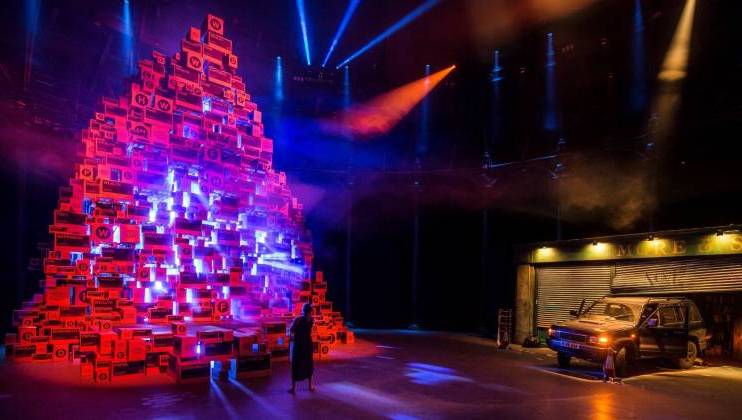Interview with Gideon Berger: Block9
London Calling spoke to Gideon Berger (Block9) about collaborating with Penny Woolcock on Utopia at Roundhouse.
By Marina Nenadic | Updated Mar 1 2022

Block9 are radicalset designers, best known for the Block9 stage at Glastonbury. Now they’ve collaborated with filmmaker and artist Penny Woolcock on Utopia, an ambitious project taking over the Roundhouse this summer. London Calling caught up with Gideon Berger, one half of Block9.
London Calling: You worked with Lana Del Rey to design the stage set for both her first European Tour in 2013 and most recent US tour 2015. Was Lana very involved in the design process?
Gideon Berger: We worked with Lana in the same way we work and collaborate with most artists. She had an idea about the flavour, feeling and vibe of what she liked and we took those ideas into an R&D period (research and development) and worked them up into a concept and then a set design. We then took these back to her and took some of her further ideas on board and vice versa. The design process was a collaboration and not the dictation of an idea from her. She’s actually really great to work with.
London Calling: Your creations are often on a grand scale- have you ever tried to build something which ended up not being feasible?
GB: In terms of the physicality of our art, the scale and ambition, no we have not ever come unstuck. Anything is possible. But it’s usually the budget, the money side of things, when projects are not feasible financially, as opposed to gravity, physics or structural engineering. We haven’t yet cooked up any mad hatter ideas that haven’t been achievable.
London Calling: If you could collaborate on a project with any person (artist, musician etc.) alive or dead, who would you choose and why?
GB: That’s difficult to say on behalf of Block9 as we are a creative partnership and my other half Steve is not here but on behalf of myself, working with ENO or the Royal Opera House would be a dream come true. We would love to get stuck into a fat, juicy opera and they are two institutions that we would love to get involved with. Personally, Jeff Mills is someone who I would love to work with. He’s the original Techo DJ an artist whose ideas transcend just electronic music and I’m a great fan of both his music and ideas.
LC: What made you both want to become set designers?
GB: I came back to the UK after living in San Francisco (from where I went to Burning Man festival a few times) and also visited NYC. At Burning Man there are amazing sound systems, epic scale art installations and I thought to myself there’s nothing going on here in the UK on that level, so let’s do something. Steve and I had been freelancing for other people and arts organizations for a long time individually on many run of the mill productions so we decided to go out on our own and do it better.
LC: Can you tell us a little more about the design for Utopia?
GB: We are working with Penny Woolcock - the lead artist - on Utopia which is based on conversations Penny had with people from the Camden area, from all sorts of backgrounds, and the things they said. We worked closely with her in finding threads of narrative - themes that came through from the conversations - which we then devised ways of ‘illustrating' in 3D as a series of spaces that you can walk through. This is a site-specific piece for Camden, where Penny wanted to drag an imaginary city into the main space at the Roundhouse, to create a space where you feel inside a film or video game rather than watching it from the outside. We have tried to create spaces that challenge the audience’s pre-conceptions of what they are hearing, what they are seeing and even where they are.
LC: What was it like collaborating with Penny Woolcock?
GB: Great. She is an incredible story-teller and seems to have an uncanny knack of being able to gain people’s trust in such an extraordinary way that they then feel free to reveal their true selves and share their most intimate stories with her.
LC: You’re best known for curating the Block 9 field at Glastonbury, which includes three immersive sets designed to house musical and theatrical performances. Where does your inspiration come from for these kinds of projects?
GB: Glastonbury has creativity at its heart and celebrates the coming together of a huge range of talents across a wide spectrum of art-forms. We take inspiration from this so a lot of our work is about hybrids - what happens when you bring different art-forms together in one place so that the boundaries become blurred. At the same time, we focus on specific musical genres or groups of musical genres and look at how they merge and evolve and we create these fantasy worlds around them. Glastonbury is such a huge festival catering to so many different tastes there is room to really hone in and truly explore what certain musical subcultures are all about.
Utopia is at Roundhouse until Sunday 23rd August. For more information, see the website.